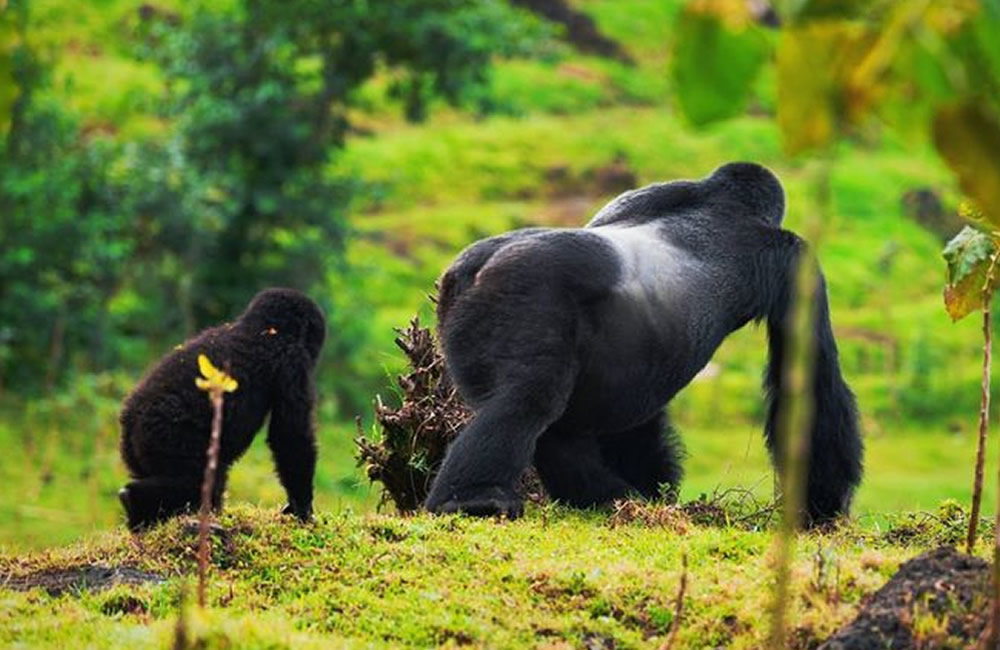Mountain Gorillas are one of the top world’s endangered species that are on the verge of extinction. Not to be confused, there are three major Gorilla types around the world; mountain, Lowland and Cross River. The Lowland are further divided into the Eastern Low land found in both Democratic Republic of Congo and Congo Brazzaville and the Western Lowland found in the countries of Central Western Africa. Cross River Gorillas are also found in low-lying and sub-montane forests in Central Western Africa.
The ‘mountain Gorillas’ are the most popular among tourists and researchers and in discussion for today.
The DNA of mountain gorillas in general is highly similar to that of a human, estimated to be 97% and gorillas are claimed to be our closest living relatives after the bonobo and chimpanzee.
Habitat
These rare ape species are approximated to be remaining only 1060 in the world and only found in three countries that share the Albertine Rift montane cloud forests of the Virunga Volcanoes; Uganda, Rwanda and Democratic Republic of Congo. They inhabits in areas within altitudes ranging from 2,200–4,300 metres or 7,200–14,100 ft and thus the name, mountain Gorillas.
Uganda Mountain Gorillas
Uganda boasts of being a home to more than a half of their total population, inhabited in the Mgahinga Forest and Bwindi Impenetrable forest. However, Bwindi has the most number with several Gorilla groups such as Mubare, Habinyanja, Bweza among others distributed into four main sections of Rushaga, Nkuringo, Buhoma and Ruhija Mgahinga has only one Gorilla group called Nyakagezi.
Rwanda and DR Congo Mountain Gorillas
Rwanda comes in the second place to posses the highest number of Gorillas, residing in the Virunga ranges’ Volcanoes Forest
Democratic republic of Congo has the least number of Gorillas among the three countries, found in the forests of its section of the massive Virunga ranges.
Way Of Life of the Mountain Gorillas
- All Gorilla’s natural habitats cover tropical or subtropical forests, the reason they are only found in Africa.
- Mountain Gorillas live in close-knit groups of 5 to 30 gorillas, headed by one supreme leader, the Silverback. The Silver back is a large, dominant male that inherits it’s name from its distinctive grey saddle pattern that grows in at its back with maturity and typically more than 12 years of age.
- The silverback is the center of the group’s attention, making all the decisions, mediating conflicts, determining the movements of the group, leading the others to feeding sites and taking responsibility for the safety and well-being of the group or family.
- They tend to emigrate from their natal groups with females dispersing more than males some times to other groups or create new ones once they join the mature males that have also left theirs.
- The male mountain gorillas (black backs) that choose to stay in their natal troops, become subordinate to the silverback without permission of mating with the females till the Silver back dies for they fight for dominance between themselves.
- Just like in humans, aggressive behaviors have also been spotted in these species though rarely lead to serious injuries. The fights may occur between female to females (common as they fight for social access to males), male to males (rare but mostly occur when the Silverback dies or grows old and weaker), male to females (rare) among others.
- Reports say that Male Gorillas in all-male groups, tend to have friendly interactions and socialize through play, grooming and staying together though may occasionally even engage in homosexual interactions.
- Severe aggression is rare in stable groups, but when two mountain gorilla groups meet, the two silverbacks can sometimes engage in a fight to the death, using their canines to cause deep, gaping injuries.
Physical Characteristics
- The weight of Mountain Gorillas depends on their gender. Adult Males usually weigh around 140 to 200 kg while adult females are half as much as males at 70 to 120 kg. However, silverbacks can weigh up to 240 kg and Obese gorillas as much as 290 kg.
- The height also depends on thir sex, with adult males being tall up to 1.6 to 1.9m with an arm span stretching from 2.2 to 2.8 m though Silverbacks can go beyond that. Females are shorter and also with smaller arm spans.
- The mountain gorilla are the darkest of all and has the thickest hair with a dark brown eye color with a black ring framed around the iris.
- Just like us, humans, all gorillas have individual finger prints and their leading cause of death is cardiovascular related diseases.
- Taken to the humans side, Gorillas are mainly of Blood group O since studies have proven that their blood is not reactive to A and B monoclonal antibodies.
Reproduction
Studies and close monitoring reveals that females mature at around 10–12 years whereas males at 11–13 years. A female’s first ovulatory cycle occurs when she is six years of age that is followed by a two-year period of adolescent infertility.
The gestation period lasts 8.5 months they gorillas first give birth at 10 years of age and have four-year afterbirth intervals. Just like humans, Males can be fertile before reaching adulthood and can mate year round.
Mating/ Copulation Incitation
Once a mountain Gorilla wants to mate or copulate, it will show different signs that are also clearly understood by its opposite party.
A Female can purse its lips and slowly approach a male while making eye contact and if the male does not respond, then she will try to attract his attention by reaching towards him or slapping the ground.
On the other side, a male can also incite copulation by approaching a female and displaying at her or touching her and giving a “train grunt”.
Most weird of all regarding copulation in these endangered species, they can also do sex while facing each other, a trait considered unique to humans.
Parenting
Mother Gorillas are the primary care givers of the infants in the group that are vulnerable and dependents and stay with them for the first five months. The only role that male gorillas play for the young in the group is to socialize them to others.
However, the silver-back has a largely supportive relationship with the infants in his group. He shields them from aggression and the mother Gorilla always stay close to him. At around 18–21 months, the infants start to detach from their mothers and regularly spend time away from each other but always the mother checks on them once every two hours for suckling.
An infant, now considered a Juvenile is weaned at around the sixth year and this is when it starts to sleep in a separate nest from their mothers. The mother starts to ovulate again and eligible to become pregnant.
Lifespan
All gorillas mostly live between 35 to 40 years.
Communication
Gorillas have their ways of communications depending on which message meant to be passed. Research indicates that 25 distinct vocalizations are recognized.
Gorillas have distinct sounds for indicate the whereabouts of individual group members, during social interactions mostly when discipline is required, alarming and warnings, contentment.
Top Mountain Gorilla Fears
Mountain gorillas that have been studied appear to be naturally afraid of certain reptiles such as snakes. However, Infants, whose natural behavior is to chase anything that moves, will go out of their way to avoid chameleons and caterpillars.
Gorillas are also afraid of water and will cross streams only if they can do so without getting wet. In this, they always cross with the help of fallen logs over the stream. They also dilike rain as well as observed and noted by Dian Fossey.
Mountain Gorilla Trekking
To be able to enjoy a gorilla tracking you need to buy a permit which is issued by the countrie’s Wildlife Authority. A number of only eight people per group per day are allowed thus being necessary to book permits as early as possible.
Permit Fees
Gorilla Trekking Permits prices vary depending on the country that you wish to track from that you can book and purchase on your own or through a travel agency you can find and agree with on the Internet. These can organize for you a travel itinerary including booking for you the accommodation, transport, tour guide, meals and other tour activities with just a single quoted price.
Some of them can also rent cars for self drive and let you drive to your preferred destinations for any period of time despite being or not being knowledgeable of the area.
It is always advisable to book at least three months in advance to ensure that you can track on the requested date.
Uganda
Uganda Gorilla tracking permits cost US $600 per person with the intention that a portion of the fee goes to the park and gorilla conservation initiatives, helping to ensure the gorilla survival.
However, the East African residents (Locals from Uganda, Burundi, Rwanda, Kenya and Tanzania) have a subsidized price of Uganda Shillings 250,000 (Approximately US $70) and Foreign East African Residents of US $500.
Foreign East African Residents are foreigners from countries that are not within the East African Community but have varied East African working permits.
Democratic Republic of Congo
Congo Gorilla Trekking in the Virunga only costs you US $400 per person for the foreigners and US $150 for the Locals. However, the policy of a deduction in the Gorilla trekking permits of East African Residents and Foreign East African Residents does not apply in Congo since she is not a member of the East African Community.
Rwanda
Rwanda Gorilla Permits currently costs US $1500 per person and the policies of East African Residence and Foreign East African Residence do not apply for now.
Top Mountain Gorilla Threats
There are a number of threats to the gorilla survival and these include;
Poaching
Though the number of Mountain Gorilla poaching has decreased with time due to the number of measures put up by the three countries’ tourism industries, in the past, they were not just merely hunted for bush meat. They were rather killled for their their heads, hands, and feet, which are sold to collectors.
Reports have it that Infants were being sold to zoos, researchers, and people who want them as pets and literally, the abduction of infants generally involves the loss of at least one adult, as members of a group will fight to the death to protect their young.
Habitat loss
This is another severe threat to gorilla populations. The forests where mountain gorillas live are surrounded by rapidly increasing human settlement. Through shifting agriculture, pastoral expansion and logging, villages in forest zones cause fragmentation and degradation of habitat. This leads to massive reduction in mountain gorilla population numbers as they try to confine to new places that may be with unfavorable living conditions to them.
Disease
The life of Mountain Gorillas is relatively more fragile as compared to that of humans. Groups subjected to regular visits from tourists and locals are at a continued risk of disease cross-transmission such as influenza, cholera, Tuberculosis or cough among others. With a similar genetic makeup to humans and an immune system that has not evolved to cope with human disease, this poses a serious conservation threat.
War and civil unrest
Rwanda, Uganda and the Democratic Republic of Congo have been politically unstable and beleaguered by war and civil unrest over the last decades though it seems to have cooled off in the former two countries. Though the Virunga side of Congo happens to be more protected from insecurities, the bigger part of Democratic Republic of Congo to date still bear evidences of Political Unrest a thing that has a negative impact on the habitat and populations of mountain gorillas.

















